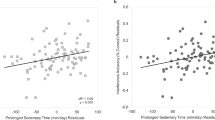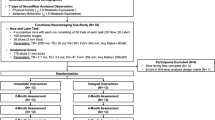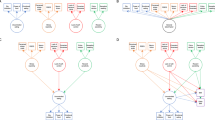Abstract
Background:
Obese individuals are known to be more impulsive than their normal-weight counterparts. Impulsivity has been postulated to be a predictor of weight loss.
Design:
A pre–post study was designed to determine for the first time whether impulsivity changed with weight loss during a lifestyle and physical activity intervention programme lasting 2–8 weeks.
Subjects:
Fifty-three obese adolescents with a body mass index (BMI) of 33.75±7.9 attending a residential camp were tested and compared at baseline with 50 non-obese adolescents with a mean BMI of 20.6±2.3.
Measurements:
Inhibitory control was measured with the CANTAB (Cambridge Cognition, Cambridge, UK) Stop Signal Task. MATLAB (The Mathswork Inc., Natick, MA, USA) was used to measure the temporal discounting constant.
Results:
The obese group was more impulsive than the normal weight adolescents. BMI reduced significantly from 33.76 kg m−2 to 30.93 kg m−2 after completing camp. The stop signal reaction time (SSRT) decreased from 225.38±94.22 to 173.76±107.05 ms (n=47, P=0.0001). A reduction in inhibitory control during camp was predictive of those who showed the greatest reduction in BMI (Wilks’ Lambda=0.9, F(1,50)=4.85, P=0.034). The number of weeks in camp (Wilks’ Lambda=0.83, F(1,50)=9.826, P=0.003) and the age of the adolescents (Wilks’ Lambda=0.87, F(1,50)=5.98, P=0.02) were significantly associated with a reduction in inhibitory control as measured by the SSRT. A longer stay in camp was associated with a greater reduction in SSRT (B=25.45, t=2.02, P=0.05). Increasing age had a significant moderating role in the reduction of inhibitory control (B=−0.3, t=−0.034, P=0.05). Temporal discounting for monetary reward also fell significantly during camp.
Conclusion:
This study highlights the potential to identify those who are obese by using an easy-to-measure psychometric test. Furthermore, it is the first study to report a reduction in impulsivity and an improvement in well-being as part of a government-approved residential camp for obese adolescents. The potential mechanisms for change in impulsivity with weight are discussed.
This is a preview of subscription content, access via your institution
Access options
Subscribe to this journal
Receive 12 print issues and online access
$259.00 per year
only $21.58 per issue
Buy this article
- Purchase on Springer Link
- Instant access to full article PDF
Prices may be subject to local taxes which are calculated during checkout
Similar content being viewed by others
References
Lobstein T, Baur L, Uauy R . Obesity in children and young people: a crisis in public health. Obes Rev 2004; 5: 4–85.
Whitaker RC, Wright JA, Pepe MS, Seidel KD, Dietz WH . Predicting obesity in young adulthood from childhood and parental obesity. N Engl J Med 1997; 337: 869–873.
Lobstein T, Jackson-Leach R . Estimated burden of paediatric obesity and co-morbidities in Europe. Part 2. Numbers of children with indicators of obesity-related disease. Int J Pediatr Obes 2006; 1: 33–41.
Ziauddeen H, Farooqi S, Fletcher P . Obesity and the brain: how convincing is the addiction model. Neuroscience 2012; 13: 279–286.
Batterink L, Yokum S, Stice E . Body mass correlates inversely with inhibitory control in response to food among adolescent girls: an fMRI study. Neuroimage 2010; 52: 1696–1703.
Sullivan S, Clonninger CR, Przybeck TR, Klein S . Personality characteristics in obesity and relationship with successful weight loss. Int J Obes (Lond) 2007; 31: 669–674.
International Society for Research on impulsivity http://www.impulsivity.org (accessed on 1 November 2013).
Weller RE, Cook EW, Avsar KB, Cox JE . Obese women show delay discounting than healthy-weight women. Appetite 2008; 51: 563–569.
Pauli-Pott U, Albayrak O, Hebebrand J, Pott W . Child Association between inhibitory control capacity and body weight in overweight and obese children and adolescents: dependence on age and inhibitory control component. Child Neuropsychol 2010; 16: 592–603.
Nederkoorn C, Jansen E, Mulkens S, Jansen A . Impulsivity predicts treatment outcome in obese children. Behav Res Ther 2007; 45: 1071–1075.
Nederkoorn C, Houben K, Hofmann W, Roefs A, Jansen A . Control yourself or just eat what you like? Weight gain over a year is predicted by an interactive effect of response inhibition and implicit preference for snack foods. Health Psychol 2010; 29: 389–393.
Fox MD, Corbetta M, Snyder AZ, Vincent JL, Raichle ME . Spontaneous neuronal activity distinguishes human dorsal and ventral attention systems. Proc Natl Acad Sci USA 2006; 103: 10046–10051.
Corbetta M, Shulman GL . Control of goal-directed and stimulus-driven attention in the brain. Nat Rev Neurosci 2002; 3: 201–215.
Seeley WW, Menon V, Schatzberg AF, Keller J, Glover GH, Kenna H et al. Dissociable intrinsic connectivity networks for salience processing and executive control. J Neurosci 2007; 27: 2349–2356.
Sridharan D, Levitin DJ, Menon V . A critical role for the right fronto-insular cortex in switching between central-executive and default-mode networks. Proc Natl Acad Sci USA 2008; 105: 12569–12574.
Simmons WK, Martin A, Barsalou LW . Pictures of appetizing foods activate gustatory cortices for taste and reward. Cereb Cortex 2005; 15: 1602–1608.
Kullmann S, Pape A, Heni M, Ketterer C, Haring H, Fritsche A . Functional network connectivity underlying food processing: disturbed salience and visual processing in overweight and obese adults. Cereb Cortex 2012; 23: 1247–1256.
Buckner RL, Andrews-Hanna JR, Schacter DL . The brain’s default network: anatomy, function, and relevance to disease. Ann NY Acad Sci 2008; 1124: 1–38.
Shannon BJ, Raichle ME, Snyder AZ, Fair DA, Mills KL, Zhang D et al. Premotor functional connectivity predicts impulsivity in juvenile offenders. Proc Natl Acad Sci USA 2011; 108: 11241–11245.
Buckner RL, Carroll DC . Self-projection and the brain. Trends Cogn Sci 2007; 11: 49–57.
Astafiev SV, Shulman GL, Stanley CM, Snyder AZ, Van Essen DC, Corbetta M . Functional organization of human intraparietal and frontal cortex for attending, looking, and pointing. J Neurosci 2003; 23: 4689–4699.
Miller EK . The prefrontal cortex and cognitive control. Nat Rev Neurosci 2000; 1: 59–65.
Sakagami M, Pan X, Uttl B . Behavioral inhibition and prefrontal cortex in decision-making. Neural Netw 2006; 19: 1255–1265.
Eigsti I-M, Zayas V, Mischel W, Schoda Y, Ayduk O, Dadlani MB et al. Predicting cognitive control from preschool to late adolescence and young adulthood. Psychol Sci 2006; 17: 478–485.
Kelly KP, Kirschenbaum DS . Immersion treatment of child and adolescent obesity: the first review of a promising intervention. Obes Rev 2011; 12: 37–49.
Thamotharan S, Lange K, Zale E, Huffhines L, Fields S . The role of impulsivity in paediatric obesity and weight status: A meta-analytic review. Clin Psychol Rev 2012; 33: 253–262.
Must A, Anderson SE . Body mass index in children and adolescents: considerations for population-based applications. Int J Obesity 2006; 30: 590–594.
Logan GD, Schachar RJ, Tannock R . Impulsivity and inhibitory control. Psychol Sci 1997; 8: 60–64.
Verbruggen F, Logan GD . Models of response inhibition in the stop-signal and stop-change paradigms. Neurosci Biobehav Rev 2009; 33: 647–661.
Rubinstein RY . Simulation and the Monte Carlo Method: Systems, Models, Simulation, and the Monte Carlo Methods. John Wiley & Sons Inc.: Hoboken, NJ, USA, 1981.
Kable JW, Glimcher PW . The neural correlate of subjective value during intertemporal choice. Nat Neurosci 2007; 10: 1625–1633.
Cloninger CR, Przybeck TR, Svrakic DM, Wetzel RD . The Temperament and Character Inventory (Tci): A Guide to its Development and Use. St. Louis. University Centre for Psychobiology and Personality: Washington, DC, USA, 1994.
Chotai J, Jonasson M, Hagglof B, Adolfsson R . The temperament scale of novelty seeking in adolescents shows an association with season of birth opposite to that in adults. Psychiatry Res 2002; 111: 45–54.
Goth K, Schmeck K . A German version of the junior temperament and character Inventory. Eur Child Adolesc Psychiatry 1999; 8: 175.
Gothelf D, Aharonovsky O, Horesh N, Carty T, Apter A . Life events and personality factors in children and adolescents with obsessive-compulsive disorder and other anxiety disorders. Compr Psychiatry 2004; 45: 192–198.
Lyoo IK, Han CH, Lee SJ, Yune SK, Ha JH, Chung SJ et al. The reliability and validity of the junior temperament and character inventory. Compr Psychiatry 2004; 45: 121–128.
Schmeck K, Goth K, Poustka F, Cloninger RC . Reliability and validity of the junior temperament and character inventory. Int J Methods Psychiatr Res 2006; 10: 172–182.
De Fruyt F, Van De Wiele L, Van Heeringen C 2000; 29: 441–452.
The Good Childhood Index, The Children’s Society. http://www.childrenssociety.org.uk/what-we-do/research/well-being/background-programme/good-childhood-index Accessed 20 January 2013.
Dolan P, Layard R . Metcalfe. Measuring Subjective Well-being for Public Policy. Office for National Statistics: London, UK, 2011.
Goldfield GS, Moore C, Henderson K, Buchholz A, Obeid N, Flament MF . Body dissatisfaction, dietary restraint, depression, and weight status in adolescents. J Sch Health 2010; 80: 186–192.
Duncan MJ, Al-Nakeeb Y, Nevill AM, Jones MV . Body dissatisfaction, body fat and physical activity in British Children. Int J Pediatr Obes 2006; 1: 89–95.
Bonnelle V, Ham TE, Leech R, Kinnunen KM, Mehta MA, Greenwood RJ et al. Salience network integrity predicts default mode network function after traumatic brain injury. Proc Natl Acad Sci USA 2012; 109: 4690–4695.
Stice E, Yokum S, Burger KS, Epstein LH, Small DM . Youth at risk for obesity show greater activation of striatal and somatosensory regions to food. J Neurosci 2011; 31: 4360–4366.
Danner UN, Ouwehand C, van Haastert NL, Hornsveld H, de Ridder DT . Decision-making impairments in women with binge eating disorder in comparison with obese and normal weight women. Eur Eat Disord Rev 2012; 20: e56–e62.
Garcia-Garcia I, Jurado MA, Garolera M, Segura B, Marques-Iturria I, Pueyo R et al. Functional connectivity in obesity during reward processing. Neuroimage 2012; 66C: 232–239.
Spreng RN, Mar RA, Kim ASN . The common neural basis of autobiographical memory, prospection, navigation, theory of mind, and the default mode: a quantitative meta-analysis. J Cogn Neurosci 2009; 21: 489–510.
Ogden J . Health Psychology: A Textbook 4th edn McGraw-Hill International: Maidenhead, UK, 2007.
Davidson TL, Kanoski SE, Schier LA, Clegg DJ, Benoit SC . A potential role for the hippocampus in energy intake and body weight regulation. Curr Opin Pharmacol 2007; 7: 613–616.
Berridge KC, Kringelbach ML . Building a neuroscience of pleasure and well-being. Psychol Well-Being 2011; 1: 1–3.
Hillman CH, Erickson KI, Kramer AF . Be Smart, exercise your heart: exercise effects on brain and cognition. Neuroscience 2008; 9: 59–65.
Author information
Authors and Affiliations
Corresponding author
Ethics declarations
Competing interests
The authors declare no conflict of interest.
Rights and permissions
About this article
Cite this article
Kulendran, M., Vlaev, I., Sugden, C. et al. Neuropsychological assessment as a predictor of weight loss in obese adolescents. Int J Obes 38, 507–512 (2014). https://doi.org/10.1038/ijo.2013.198
Received:
Revised:
Accepted:
Published:
Issue Date:
DOI: https://doi.org/10.1038/ijo.2013.198
Keywords
This article is cited by
-
The effect of continuous theta burst stimulation on antipsychotic-induced weight gain in first-episode drug-naive individuals with schizophrenia: a double-blind, randomized, sham-controlled feasibility trial
Translational Psychiatry (2024)
-
Current perspectives on brain circuits involved in food addiction-like behaviors
Journal of Neural Transmission (2024)
-
Current and future pharmacotherapies for obesity in children and adolescents
Nature Reviews Endocrinology (2023)
-
Effects of physical activity interventions on cognitive performance of overweight or obese children and adolescents: a systematic review and meta-analysis
Pediatric Research (2021)
-
Cognitive remediation-enabled cognitive behaviour therapy for obesity: a case series
Eating and Weight Disorders - Studies on Anorexia, Bulimia and Obesity (2021)



